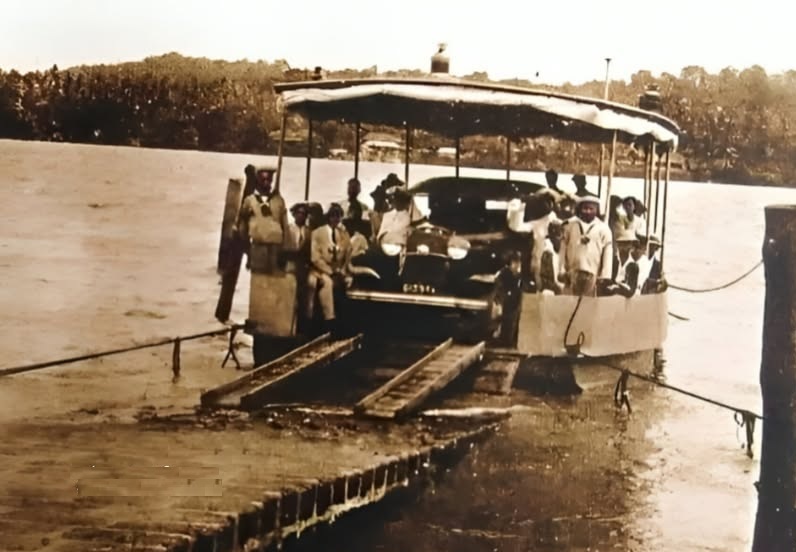
With its intricate network of rivers, creeks, and backwaters, Goa has historically relied on waterways as much as on roads. For centuries, ferry services have played a crucial role in the State’s transportation system, enabling movement across its many rivers and estuaries. During the Portuguese colonial era (1510–1961), ferries were introduced sometime in the 1880s serving as lifelines for trade, travel, and daily commuting, in the absence of bridges. These traditional ferries were usually wooden boats, manually rowed by skilled oarsmen who knew the tides and currents well. Over time, ferries evolved from simple hand-rowed vessels to mechanised boats, yet they continue to hold cultural and practical significance in Goa’s rural and riverine communities.
Ferry services in Goa traditionally relied on manual methods, with wooden boats either rowed or poled by local boatmen. Operated primarily by families or riverbank communities, these ferries were often flat-bottomed, designed to transport both passengers and goods across the waterways. Known locally as catas, they formed an essential part of daily life, linking villages and towns scattered along the riverbanks.
During the Portuguese colonial period, the administration continued to regulate these ferry services by issuing licenses, assigning boats to key river crossings, and collecting taxes. In some cases, the state provided subsidies, particularly for ferries serving important trade routes, religious centers, or remote communities. These services not only supported local commerce and travel but also helped maintain social and cultural ties across regions divided by rivers.
Ferries played a vital role in facilitating pilgrimage routes in Goa, particularly during major religious events such as the Feast of St. Francis Xavier at Old Goa. These gatherings drew thousands of devotees from across the state and beyond, with ferries serving as the primary mode of transport for pilgrims, clergy, and church officials. The seamless movement of large crowds across rivers was made possible by the strategic operation of ferry services during such occasions.
Beyond their religious significance, ferries were also deeply integrated into Goa’s agrarian economy during the Portuguese era. The state’s fertile riverbanks and hinterlands depended on water transport to move agricultural produce like rice, coconuts, spices, and firewood to urban markets. Ferries enabled farmers and traders to access economic hubs efficiently, contributing to the rural-urban exchange of goods.
Boats in Portuguese-era Goa
Goa’s rivers and backwaters were bustling with various types of boats designed for specific purposes—ranging from transportation and trade to fishing and ferrying. These boats were typically made from locally sourced timber and crafted by traditional boat-builders with deep knowledge of riverine navigation.Pangaios is a long and narrow boat, with high sides for stability in deeper waters. Commonly used for transporting agricultural produce like rice, coconuts, and firewood. Vellams (also known as Vallams or Canoas) were among the most common traditional boats used in Portuguese-era Goa. These small, narrow craft were typically dugout canoes, carved from hollowed tree trunks by skilled local artisans. Their simple yet sturdy design made them ideal for navigating the shallow creeks, estuaries, and backwaters of Goa. Vellams were also important for transporting small loads of goods, such as vegetables, firewood, or fish, to nearby markets. Catra was a traditional passenger ferry, manually rowed or sailed, common on shorter river crossings.
Pangadões or Patmaris were large, sail-powered wooden boats used for long-distance coastal and inter-port trade with the Malabar and Konkan coasts. Shampan /Sampan were traditional wooden boats, originally of Chinese and Southeast Asian origin, that were adapted and occasionally used in Goa, especially in coastal and port areas. Small wooden boats were used for ferrying people and goods. Used primarily for coastal transport, fishing, and cargo movement in sheltered waters, these boats featured a broad-beamed, flat-bottomed wooden designwithraised bows and sterns. Some were equipped with small shelters or cabins. Ideal for calm waters such as estuaries, harbors, and river mouths, they carried goods, and passengers, and occasionally served fishing purposes. Depending on the need, they could be rowed, poled, or fitted with sails for easier navigation.
Falúas, elegant boats from Spain and Portugal, likely influenced Goan maritime designs during Portuguese rule. Gracefully designed and often decorated, these sail- or oar-powered vessels served officials, clergy, and nobility for ceremonial and official duties, especially during religious processions, adding grandeur to riverine events and enhancing coastal and river transport. Batelão is a large wooden flat-bottomed barge used for bulk cargo transport such as heavy cargo loads like iron ore, timber, and other goods, and passengers. The batelão, a testament to the ingenuity of Goan boat-building traditions, was used for loading/unloading cargo to and from ships anchored offshore.
Around 1880, a motorised Lancha (or vaafor) was introduced for patrolling and official tasks, its speed and agility aiding authorities in monitoring waterways and transporting officials across Mandovi and Zuari for customs, security, and administrative duties. Ferry boats later connected Panaji to Savordem, Volvoi, Aldona, Betim, Verem, and Mormugao. The Panaji-Savordem ferry would leave at 11AM, reaching Savordem by 5PM, stopping at Ribandar, Old Goa, Cumbarjua, Kundaim, Dongri, Madkai, Undir, Durbhat, Borim, Raitur, and Maanki. The return ferry departed at 8AM, arriving in Panaji by 2PM. The Panaji -Betim ferry, with space for a car and a few passengers, allowed vehicles to be driven onto the ferry/ramp using a set of wooden planks. Thanks to the Portuguese for ramps and riverine mobility ideas, the River Navigation Department redesigned ferry services across 19 routes across Goa after liberation.